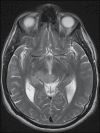A clinical perspective on the 2016 WHO brain tumor classification and routine molecular diagnostics
- PMID: 28339700
- PMCID: PMC5464438
- DOI: 10.1093/neuonc/now277
A clinical perspective on the 2016 WHO brain tumor classification and routine molecular diagnostics
Abstract
The 2007 World Health Organization (WHO) classification of brain tumors did not use molecular abnormalities as diagnostic criteria. Studies have shown that genotyping allows a better prognostic classification of diffuse glioma with improved treatment selection. This has resulted in a major revision of the WHO classification, which is now for adult diffuse glioma centered around isocitrate dehydrogenase (IDH) and 1p/19q diagnostics. This revised classification is reviewed with a focus on adult brain tumors, and includes a recommendation of genes of which routine testing is clinically useful. Apart from assessment of IDH mutational status including sequencing of R132H-immunohistochemistry negative cases and testing for 1p/19q, several other markers can be considered for routine testing, including assessment of copy number alterations of chromosome 7 and 10 and of TERT promoter, BRAF, and H3F3A mutations. For "glioblastoma, IDH mutated" the term "astrocytoma grade IV" could be considered. It should be considered to treat IDH wild-type grades II and III diffuse glioma with polysomy of chromosome 7 and loss of 10q as glioblastoma. New developments must be more quickly translated into further revised diagnostic categories. Quality control and rapid integration of molecular findings into the final diagnosis and the communication of the final diagnosis to clinicians require systematic attention.
Keywords: 1p/19q codeletion; 7+/10LOH; IDH; WHO classification; glioma.
© The Author(s) 2017. Published by Oxford University Press on behalf of the Society for Neuro-Oncology. All rights reserved. For permissions, please e-mail: journals.permissions@oup.com.
Figures




Comment in
-
Reappraising the 2016 WHO classification for diffuse glioma.Neuro Oncol. 2017 May 1;19(5):609-610. doi: 10.1093/neuonc/nox003. Neuro Oncol. 2017. PMID: 28379471 Free PMC article. No abstract available.
References
-
- Louis DN, Perry A, Reifenberger G, et al. The 2016 World Health Organization classification of tumors of the central nervous system: a summary. Acta Neuropathol. 2016;131(6):803–820. - PubMed
-
- Sahm F, Reuss D, Koelsche C, et al. Farewell to oligoastrocytoma: in situ molecular genetics favor classification as either oligodendroglioma or astrocytoma. Acta Neuropathol. 2014;128(4):551–559. - PubMed
-
- Wick W, Hartmann C, Engel C, et al. NOA-04 randomized phase III trial of sequential radiochemotherapy of anaplastic glioma with procarbazine, lomustine, and vincristine or temozolomide. J Clin Oncol. 2009;27(35):5874–5880. - PubMed
-
- Miller CR, Dunham CP, Scheithauer BW, et al. Significance of necrosis in grading of oligodendroglial neoplasms: a clinicopathologic and genetic study of newly diagnosed high-grade gliomas. J Clin Oncol. 2006;24(34):5419–5426. - PubMed
Publication types
MeSH terms
LinkOut - more resources
Full Text Sources
Other Literature Sources
Medical
Research Materials

